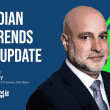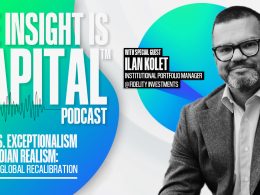by Kristina Hooper, Invesco Canada
Kristina Hooper looks back at five issues that pressured markets in April and explores the “glass half full” moments she sees in each one.
Well, there’s no other way to describe April than that it truly was a mensis horribilis. While you probably don’t want a recap of the past “horrible month,” I think it’s important to share the key takeaways—including some “glass half full” moments that give me some optimism for the months ahead.
Five issues that pressured markets in April
Russia-Ukraine conflict. Russia’s war with Ukraine has become a war of attrition. It has gotten even more brutal, with terrible atrocities committed against the Ukrainian people. Last week, Russia announced it would no longer sell its natural gas to Poland and Bulgaria because of its new requirement that its gas be paid for in Russian rubles. European gas prices rose significantly on the news before re-tracing some of the gains.1
Earnings season. Earnings thus far have helped depress market sentiment, largely because of what we are hearing about current conditions and guidance for the future – in addition to a few high profile misses. One key theme has been supply chain disruptions, which not only have continued, but in some cases have worsened.
For example, 3M shared that it was hurt by weak sales in the auto industry, which in turn has been hurt by supply chain disruptions including semiconductor shortages. 3M’s CEO recognized some improvement in conditions around COVID-related absenteeism but has changed his assessment of supply chain challenges; he now expects them to continue for the “foreseeable future.”2 General Electric also referenced supply chain pressures on its earnings call, with its CEO saying he expects it will be a challenge for the rest of the year. And Apple shared that iPad sales fell 2% because of supply chain constraints, and that they expect continued supply chain issues in the third quarter.3 The other key theme was higher input costs. In general, companies conveyed significant challenges for the rest of the year.
COVID lockdowns in China. China’s two largest cities, Shanghai and Beijing, are both still experiencing lockdown measures along with some other smaller cities. This has had a significant negative impact on the economic outlook for the country, as evidenced by April’s Purchasing Managers Index (PMI) data. Caixin China Manufacturing PMI dropped to 46.0 in April, which represented a 26-month low.4 This was driven by a drop in output and new orders, as well as a decline in export orders. In addition, delivery times increased. The official Manufacturing PMI data from China’s National Bureau of Statistics painted a similar picture, as the April reading dropped to 47.4 from 49.5 in March.5 This is the second straight month in which the PMI reading is below 50, suggesting contractionary conditions. This reading was largely hurt by a substantial drop in output as well as declines in new orders and new export orders.
Apprehension over central bank tightening. The U.S. Federal Reserve (Fed) is meeting this week, as is the Bank of England, which has investors on edge. But in general, “central bank speak” and continued hawkish pivots have cast a pall over markets in April, as investors arguably anticipate a big step in early May on the path to neutral (or possibly restrictive) monetary policy.
Stock market sell-off. Not surprisingly, risk assets did not respond well to this very difficult environment, with global equities having dropped nearly 10% for the month.6 But few asset classes avoided the carnage; we saw high yield bonds, investment grade corporate bonds and sovereign debt experiencing some losses during the month. Energy and agriculture were some of the few areas that actually experienced gains for the month.
Given everything going on in April, it seems only fitting that this month also brought us a wild turkey that attacks pedestrians near Washington, D.C.’s Anacostia Riverwalk Trail. This turkey has been deemed so dangerous that the Prince George’s County Parks and Recreation Department has put out a warning to residents to “keep their distance.” It seems the turkey has anger management issues and is “looking for trouble,” nipping joggers on their derrieres and even jumping in the air to attack bicyclists.7 I was struck by this news piece, as it seems like nothing can go right when even our feathered friends become vicious predators.
Is the glass half full?
But sometimes, it’s when nothing seems like it can go right that we actually find some of the best opportunities. If nothing else, I think we can find some “glass half full” takeaways from the month of April:
Russia-Ukraine conflict. One positive is that we have thus far avoided having more countries enter the conflict — and we have avoided a nuclear war. What’s more, just as the energy crisis of the 1970s encouraged the United States to seek energy independence, this situation seems to be encouraging Europe to find alternate sources of energy that enable it to no longer rely on Russia. Several days ago, Germany’s Federal Ministry of Economics and Technology announced that it has targeted the end of summer to end its reliance on Russian oil (this is a faster timeline than the previous target, which was to end dependence on Russian oil by end of year), although it is likely to still rely on Russia’s natural gas until 2024.
I believe former U.S. President Donald Trump was right in pointing out that it was a mistake for Germany and other European nations to rely on Russian natural gas — and they clearly recognize that now that Russia has invaded Ukraine — but new infrastructure needs to be built to tap into other supply sources, so this isn’t a change that can happen as quickly as it can for oil. Having said that, the U.S. has increased exports of liquefied natural gas to Europe in recent weeks, so progress is being made. The desire for energy independence in Europe should also stimulate investment in renewable energy infrastructure.
In addition, this conflict has obviously helped revive the importance of NATO and has, in at least some ways, helped unite the European Union. European leaders have emphasized the importance of a coordinated response in this crisis; EU ministers are holding emergency talks on May 2 to arrive at a united response to the immediate problem of Russia cutting off gas to Poland and Bulgaria. In my view, these are all positive developments for the longer term.
Earnings season. Earnings have been relatively good, given the challenging environment we are in. With 55% of S&P 500 Index companies having reported thus far, 80% have reported a positive earnings surprise and 72% have reported a positive revenue surprise.8 Admittedly, the energy sector has played a big role in these numbers, but most other sectors are also experiencing positive, if modest, earnings growth. And calendar year 2022 earnings growth forecasts for the S&P 500 have actually improved in recent weeks – now expected to be 10.3% versus 9.9% as of March 31.8 And Europe’s earnings season, despite some of the same obstacles (supply chain disruptions and higher input costs), has been quite positive thus far, actually providing a boost to European stocks at the end of last week.
COVID lockdowns in China. While COVID lockdowns are certainly negatively impacting the Chinese economy for now, this could be a short-lived problem. The Institute for Health Metrics and Evaluation provides projections on expected COVID-19 infections in coming months (I should note that in the past, the IHME has been quite accurate in its projections). It shows that infection rates in China are expected to decline dramatically by July 2022. This suggests a strong rebound in the back half of 2022 is still very possible, especially with substantial fiscal and monetary stimulus, as I have mentioned before.
Apprehension over central bank tightening. This is likely to continue, but as I have pointed out in the past, it can be a positive — investor and consumer behaviour can help tighten financial conditions and temper the stock market without central banks – especially the Fed – doing as much in the way of actual tightening.
I have heard some strategists say that the Fed doesn’t have the luxury of being data dependent given the urgency of combating inflation. I disagree. Longer-term U.S. consumer inflation expectations remain relatively well-anchored, which I believe will give the Fed confidence to take a more thoughtful, data-dependent approach to tightening. In fact, not only have longer-term U.S. consumer inflation expectations remained relatively unchanged in recent months or even ticked downward, it is also important to note that they are actually far lower than they were in 1990.
Stock market sell-off. Global stocks have been beaten down globally, which means this could be an attractive entry point for those with longer-term time horizons. While I expect continued volatility and the potential for more stock market downdrafts, this is the type of environment that I believe provides opportunities for active management.
I don’t get too concerned about stock market sell-offs, especially when I feel comfortable with the longer-term economic environment. I think this is an important time to remind ourselves of how behavioural finance biases can impact our investment decisions. Most individuals have a “recency bias.” That is a behavioural investing bias that can cause us to make mistakes by giving greater importance to what has occurred recently.
Given that we have seen a significant market sell-off in recent months, many individuals may assume this will continue and will therefore avoid investing. Recency bias can cause investment mistakes because it encourages investors to buy at or near the top of the market because they assume the rally will continue, and it discourages investors to buy at or near the bottom of the market because they assume the sell-off will continue.
I believe we should look to market sell-offs as potential entry points; those with long-term investment horizons should not be frightened by current market gyrations, in my view. Diversification and remaining invested does not work every day, but historically it has helped people achieve their goals over the long run.
As for the turkey with anger issues, I’m not sure I see a glass half full scenario here – although maybe some clever Hollywood producer will see some opportunity to create a summer blockbuster, although I am skeptical that “Turkeynado” will garner the kind of massive fan base that “Sharknado” enjoyed.
1 Source: Inter Continental Exchange (ICE) as of April 28, 2022
2 Source: Earnings call transcript, Seeking Alpha, April 26, 2022
3 Source: Reuters, “Apple sees bigger supply problems after strong start to year,” April 28, 2022
4 Source, IHS Markit Economics
5 Source: China’s National Bureau of Statistics
6 Based on the MSCI All-Country World Index (actual return for month of April: -8.41% USD) source: MSCI, as of April 29, 2022. The MSCI All Country World Index is an unmanaged index considered representative of large- and mid-cap stocks across developed and emerging markets.
7 Source: People Magazine, April 29, 2022
8 Source: FactSet Research Systems, as of April 29, 2022
This post was first published at the official blog of Invesco Canada.














